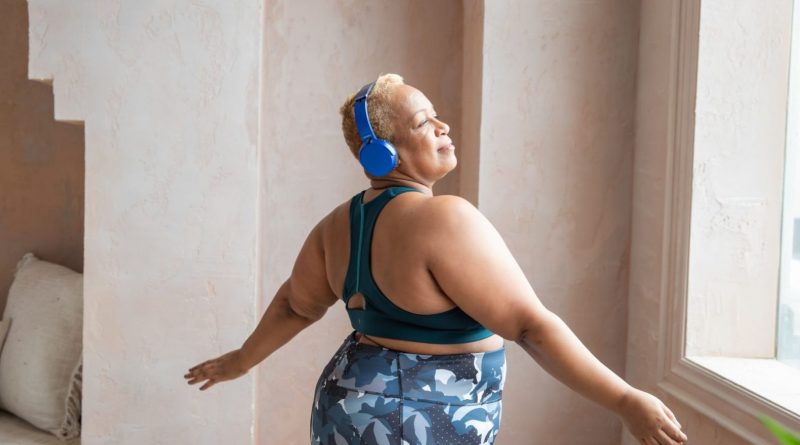January Kickstarter: 4 types of exercise that are proven to boost a low mood
This January, we’re on the search for quick, accessible hacks to kickstart 2023 in the strongest way possible. Today’s mood kickstarter: 4 exercises proven to boost low mood.
If you’re feeling low, the thought of pushing through a run or forcing yourself to relax in a yoga class might make you feel even more miserable than you already are. And yet, those who rely on exercise to boost their mood won’t stop reminding you about those post-workout endorphins.
The thing is, a lot of the mental health benefits of training happen in the long term – with research showing that regular exercise can reduce the risk of depression. But what if you’re in need of an urgent release? If you’re reading this during a stressful day at work, while feeling flat at the prospect of continued cost of living anxiety or you’ve just woken up on the wrong side of the bed, there are some types of movement that can help.
You may also like
Exercise and stress: the best exercise to help you handle stress and boost a low mood
Remember: there’s no one size fits all when it comes to exercise. And sometimes, exercise won’t touch the sides – particularly if your stress is linked to something you can’t control. As a general rule of thumb, doing something you hate will (unsurprisingly) make you feel worse. If you don’t know what to start with, why not try one of these scientifically approved workouts and see if they can give you a pick-me-up?
Dancing (at home or in a class)
There’s nothing quite like a dance to shake a bad mood off. Studies agree – one published in the Australian Journal of Psychology found that aerobic dance exercise appears to be particularly effective in enhancing mood for female exercisers, and also improved attitudes towards physical appearance and emotional stability immediately after the exercise. As for the long term, other studies show that dance therapy can alleviate symptoms of depression.
Opt for a dance-based workout, such as those seen on PT Tally Rye’s Instagram. Or go slow, trying out barre workouts that focus on ballet-esque movements. Alternatively, take a leaf out of Stylist’s editor-at-large Kayleigh Dray’s book; she dances around her kitchen when she feels rubbish. “I shove my phone in a bowl to boost the volume, and dance around like mad to whatever song pops up next on my Spotify ‘Daily Drive’ – which could be anything from Kelly Clarkson and Dua Lipa, to Avril Lavigne and My Chemical Romance (rogue, right?).
“It may take one song, it may take five, but I always dance until I’ve stopped thinking about whatever it was that was ruining my mood, or I’m too exhausted to care anymore. Either way, it works. I promise.”
Walking for 30 minutes
There’s a reason that your daily walk is so encouraged – it’s as big of a mood booster as Christmas is, according to research by the University of Vermont.
One person who loves heading out on a walk when they’re feeling low is fitness trainer Emma Obayuvana. “I love to exercise and while any training gives me a hit of endorphins, there’s something about walking that clears my head. I consciously pay attention to the things around me, whether it’s a river, pretty houses or a dog that runs past – and take note of my breathing to really calm me.

“If I’m in a bad place, I need the benefits of the exercise there and then, rather than after the workout, and walking gives that to me.”
To really boost the mental health benefits of your walk, Obayuvana’s mindfulness techniques can help. As can walking in nature, which is associated with greater mental health benefits. A 2019 study found that a 50 minute walk in a forest amplified the mood boosting outcome of a walk. However, if you don’t have access to a forest you can stroll in, 30–50 min of walking anywhere “can buffer against the wear-and-tear of daily life” the researchers concluded.
Gentle running
Running off anger, stress or sadness is a scene so often depicted in films, but it’s more than a Hollywood trope. Studies prove that running could even improve mood to the same extent as meditation. In research published in Biological Psychology, participants who ran for an hour had an elevated mood as well as an increase in the endorphins. The second group reported a similar change in mood and researchers noticed the same endorphin increase.
But you don’t have to smash out a 10k PB to get the benefits – any speed or distance will give you a mood boost. In fact, research by the University of Cologne found that cortisol levels were lower after a gentle run than a high-intensity run. But the main takeaway from most research is that running at your preferred pace, whether high or low, will be the most effective in terms of mood.
Yoga
For some, a fast-paced, energy-burning session is ideal. For others, gentle training is all they can manage when they’re feeling low. The good news is that slower workouts will still give you a mood boost. A study in the Journal of Psychology found that mindful, low-exertion activities enhanced mood after a single session – so much that the researchers “called into question the superiority of aerobic exercise over non-aerobic, mindful modes.”
Another study found that yoga is associated with an increase in GABA levels – neurotransmitters that can reduce activity in your nervous system, essentially calming you down. It’s no surprise, given that yoga is so often linked with our breath, which has been shown to ease anxiety and worry.
Whatever you do, don’t overthink it. If you’re moving to feel a little happier, then the focus should be on what makes you feel genuinely good – not what you think you should be doing.
Follow @StrongWomenUK on Instagram for the latest workouts, delicious recipes and motivation from your favourite fitness experts.
Images: Getty
Source: Read Full Article
